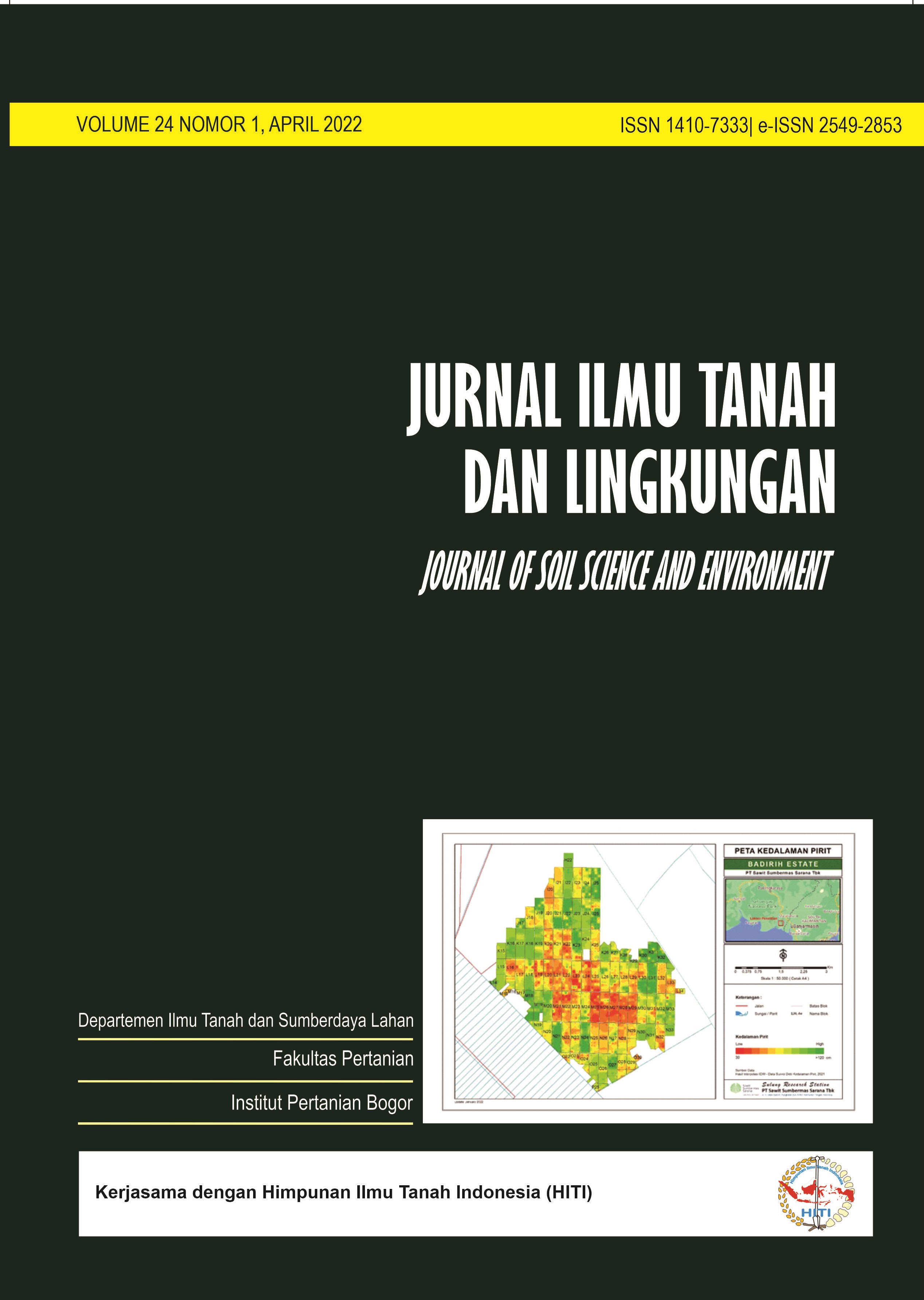Identifying Pyrite Layer Depth and Its Association to Oil Palm Health and Productivity (Elaeis guineensis Jacq.) ( A Case Study at PT Sawit Sumbermas Sarana Tbk’s Oil Palm Plantation )
Abstract
The pyrite layer (FeS2) characterizes acid sulphate soil. Under oxidized conditions, pyrite produces sulphuric acid that increases acidic soil to very acidic (pH 2-3). This condition is a threat to plantation, including oil palm plantation. Therefore, the management of acid sulphate soil must take into account the depth of pyrite layer. Studies on the identification of pyrite and the use of remote sensing in monitoring plant health are urgently required to optimize oil palm production in acid sulphate soil. In this case study, detailed survey and mapping were performed to measure the depth of pyrite followed by plant health analysis, and production analysis. The results showed that the depth of pyrite layer at the site ranged from 30 cm to over 120 cm from the soil surface. The depth indicated that the 72.40% of the soil was categorized medium pyrite depth (60-120 cm). Furthermore, 484.85 ha was shallow pyrite layer (<60 cm) and deep pyrite layer (>120 cm) covered an area of 163.75 ha. A tendency for a positive linear relationship between pyrite depth, NDVI (normalized difference vegetation index) or plant health, and plant productivity. NDVI values and plant productivity and deeper pyrite depth was identified as shown in higher NDVI values following deeper pyrite layer. Plant productivity on deep pyrite soil was significantly different from the one in medium or shallow pyrite soil. Shallower pyrite layer was followed by lower oil palm production. The productivity has decreased by 39% and 19% in soil with pyrite depths of < 60 cm and 60 cm – 120 cm respectively.
Downloads
References
Adhi, I.W., N.S. Ratmini dan I.W. Swastika. 1997. Pengelolaan Tanah dan Air Lahan Pasang Surut. In Puslibangtrans. Balai Penelitian dan Pengembangan Pertanian.
Chai, T. and R.R. Draxler. 2014. Root mean square error (RMSE) or mean absolute error (MAE)? -Arguments against avoiding RMSE in the literature. Geoscientific Model Development, 7(3): 1247–1250. https://doi.org/10.5194/gmd-7-1247-2014
Dent, D. 1986. Acid Sulphate Soils: A Baseline for Research and Development.
Dewi, A.C. 2019. Citra Sentinel-2 Untuk Identifikasi Kesehatan Kelapa Sawit Di Kebun Sei Galuh PTPN V Riau. Universitas Gadjah Mada.
Hutasuhut, A.H., W. Anggraeni dan R. Tyasnurita. 2014. Pembuatan aplikasi pendukung keputusan untuk peramalan persediaan bahan baku produksi plastik blowing dan inject menggunakan metode ARIMA (Autoregressive Integrated Moving Average) di CV. Asia. Jurnal Teknik Pomits, 3(2): A-169-A-174.
Pupathy, U.T. and S. Paramananthan. 2014. Agro-management for oil palms planted on acid sulfate soils. Selectes Paper on Soil Science - Problem Soil, June, 1–17.
Pupathy, U.T. and N. Sundian. 2020. Key agronomic management factors for maximising oil palm (Elaeis guineensis Jacq.) yields on acid sulphate soils in Malaysia and Indonesia. IOP Conference Series: Earth and Environmental Science, 454(1). https://doi.org/10.1088/1755-1315/454/1/012171
Purnomo, H. 2012. Aplikasi Metode Interpolasi inverse distance weighting dalam penaksiran sumberdaya laterit nikel. Jurnal Angkasa, 49–60.
Pusparani, S. 2018. Karakterisasi sifat fisik dan kimia pada tanah sulfat masam di lahan pasang surut. Jurnal Hexagro, 2(1): 1–4.
Santoso, H. dan A. Susanto. 2020. Dampak serangan sekunder pada budidaya tanaman kelapa sawit di lahan sulfat masam dengan tata kelola air yang tidak optimal. Warta PPKS, 25(3): 101–108.
Saputra, R. 2021. Sistem Informasi Geografis Perkebunan Kelapa Sawit Menggunakan NDVI Pada PTPN V Provinsi Riau (Vol. 2, Issue 1). Universitas Islam Negeri Sultan Syarif Kasim, Riau.
Shamshuddin, J., A. Elisa Azura, M.A.R.S. Shazana, C.I. Fauziah, Q.A. Panhwar and U.A. Naher. 2014. Properties and management of acid sulfate soils in Southeast Asia for sustainable cultivation of rice, oil palm, and cocoa. In Advances in Agronomy (1st ed., Vol. 124). Elsevier Inc. https://doi.org/10.1016/B978-0-12-800138-7.00003-6
Suastika, I.W., W. Hartatik, dan I.G.M. Subiksa. 2014. Karakteristik dan Teknologi Pengelolaan Lahan Sulfat Masam Mendukung Pertanian Ramah Lingkungan. Pengelolaan Lahan Pada Berbagai Ekosistem Mendukung Pertanian Ramah Lingkunenelitian dan Pengembangan Pertanian. Kementerian Pertanian. 2014.Gan., 1986: 95–120.
Subiksa, I.G.M. dan D. Setyorini. 2009. Pemanfaatan Fosfat Alam untuk Lahan Sulfat Masam. In Fosfat Alam : Pemanfaatan Pupuk Fosfat Alam sebagai Sumber Pupuk P (pp. 62–83). Balai Penelitian Tanah, Badan Pengembangan dan Penelitian Pertanian.
Sutandi, A., B. Nugroho dan B. Sejati. 2011. Hubungan kedalaman pirit dengan beberapa sifat kimia tanah dan produksi kelapa sawit (Elaeis guineensis). Jurnal Ilmu Tanah dan Lingkungan, 13(1): 21. https://doi.org/10.29244/jitl.13.1.21-24
Sutarta, E.S., D. Wiratmoko dan E.N. Akoeb. 2020. kesuburan tanah, pertumbuhan dan produktivitas tanaman kelapa sawit (Elaeis guineensis) pada tiga kedalaman mineral pirit. Jurnal Penelitian Kelapa Sawit, 28(2): 71–84.
Taufik, V.V., A. Sukmono dan H.S. Firdaus. 2021. Estimasi produktivitas kelapa sawit menggunakan metode NDVI (Normalized Difference Vegetation Index) dan ARVI (Atmospherically Resistant Vegetation Index) dengan Citra Sentinel-2A (Studi Kasus : Beberapa Wilayah di Provinsi Riau). Jurnal Geodesi Undip, 10(1): 153–162. https://ejournal3.undip.ac.id/index.php/geodesi/article/view/29636
Winarna. 2017. Pertumbuhan tanaman kelapa sawit di lahan pasang surut. Jurnal Pertanian Tropik, 4(1): 95–105. https://doi.org/10.32734/jpt.v4i1.3075
Yao, X., B. Fu, Y. Lü, F. Sun, S. Wang and M. Liu. 2013. Comparison of four spatial interpolation methods for estimating soil moisture in a complex terrain catchment. PLoS ONE, 8(1). https://doi.org/10.1371/journal.pone.0054660
Department of Soil Science and Land Resources Departemen Ilmu Tanah dan Sumberdaya Lahan, Faculty of Agriculture Fakultas Pertanian, IPB University



















